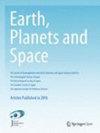Postseismic gravity changes after the 2011 Tohoku earthquake observed by superconducting gravimeters at Mizusawa, Japan
IF 2.5
3区 地球科学
引用次数: 0
Abstract
Abstract Postseismic gravity changes after the 2011 Tohoku earthquake (Mw9.0) were investigated using the data from superconducting gravimeters (SGs) at Mizusawa, Japan. The data in the period from 2014 to 2021 were used in the analysis. The SG data were first corrected for instrumental drift using the results of absolute gravity measurements. Then, correction for the hydrological effect was applied based on physical modeling of soil moisture. Finally, the effect of vertical displacement of the station (free-air effect) was corrected using GNSS data. After these corrections, residual gravity indicated a long-term increase, with its rate gradually decreasing with time. This fact suggests that viscoelastic relaxation after the earthquake played an important role in producing the long-term gravity changes. Fitting a decaying exponential function of time to the residual series yielded 89.4 ± 4.4 µGal (1 µGal = 10 –8 ms –2 ) as the total gravity change and 635 ± 17 days as the characteristic time scale. In addition to the ground-based observations, the data from satellite gravity missions GRACE/GRACE-FO were analyzed to retrieve gravity changes at Mizusawa. Similar analysis of the satellite-based data yielded 15.2 ± 1.6 µGal as the total gravity change and 3444 ± 599 days as the characteristic time scale. The difference in the estimates of the total gravity change, of a factor of about 6, from the ground-based and the satellite-based observations may be attributed to the limited spatial resolution in the latter method. The difference in the estimates of the time scale, of a factor of about 1/5, may originate from the difference in the depth where the two kinds of gravimetry are mainly sensitive. Referring to recent theoretical studies on postseismic deformations after the 2011 Tohoku earthquake, our results can be interpreted consistently by assuming the existence of a layer of viscoelastic materials with viscosity $$2\times {10}^{18} \text{Pa s}$$用超导重力仪在日本水泽观测2011年东北地震后的重力变化
利用日本水泽超导重力仪(SGs)的数据研究了2011年日本东北地震(Mw9.0)后的重力变化。分析使用了2014年至2021年期间的数据。SG数据首先使用绝对重力测量结果对仪器漂移进行了校正。然后,在土壤水分物理模拟的基础上对水文效应进行校正。最后,利用GNSS数据对台站垂直位移的影响(自由空气效应)进行校正。经过这些修正后,剩余重力呈现出长期增加的趋势,其速率随时间逐渐减小。这一事实表明,地震后粘弹性松弛在产生长期重力变化中起了重要作用。对残差序列进行时间衰减指数函数拟合,总重力变化为89.4±4.4µGal(1µGal = 10 -8 ms -2),特征时间尺度为635±17天。除了地面观测外,还分析了GRACE/GRACE- fo卫星重力任务的数据,以检索水泽的重力变化。对卫星数据进行类似分析,总重力变化为15.2±1.6µGal,特征时间尺度为3444±599天。地面观测和卫星观测对总重力变化的估计相差约6倍,这可归因于后者方法的空间分辨率有限。时间尺度估计的差异约为1/5,这可能源于两种重力法主要敏感的深度差异。结合近年来有关2011年东北地震震后形变的理论研究,我们的研究结果可以通过假设日本东北地区地下存在黏度为$$2\times {10}^{18} \text{Pa s}$$ 2 × 10 18 Pa s的粘弹性材料层来得到一致的解释。图形摘要
本文章由计算机程序翻译,如有差异,请以英文原文为准。
求助全文
约1分钟内获得全文
求助全文
来源期刊

Earth, Planets and Space
地学天文-地球科学综合
CiteScore
5.80
自引率
16.70%
发文量
167
期刊介绍:
Earth, Planets and Space (EPS) covers scientific articles in Earth and Planetary Sciences, particularly geomagnetism, aeronomy, space science, seismology, volcanology, geodesy, and planetary science. EPS also welcomes articles in new and interdisciplinary subjects, including instrumentations. Only new and original contents will be accepted for publication.
 求助内容:
求助内容: 应助结果提醒方式:
应助结果提醒方式:


